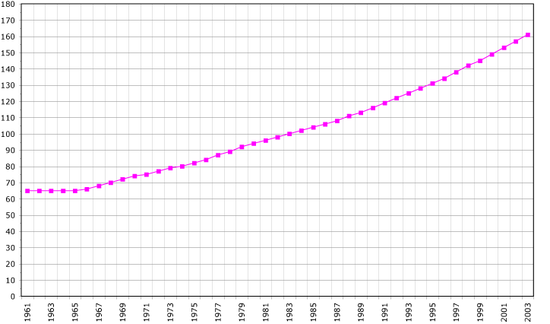Demographics of São Tomé and Príncipe
2007 Schools Wikipedia Selection. Related subjects: African Geography
Of São Tomé and Príncipe's total population, about 131,000 live on São Tomé and 6,000 on Príncipe. All are descended from various ethnic groups that have migrated to the islands since 1485. Six groups are identifiable:
- Mestiços, or mixed-blood, descendants of Portuguese colonists and African slaves brought to the islands during the early years of settlement from Benin, Gabon, the Republic of the Congo, the Democratic Republic of the Congo, and Angola (these people also are known as filhos da terra or "children of the land");
- Angolares, reputedly descendants of Angolan slaves who survived a 1540 shipwreck and now earn their livelihood fishing;
- Forros, descendants of freed slaves when slavery was abolished;
- Serviçais, contract laborers from Angola, Mozambique, and Cape Verde, living temporarily on the islands;
- Tongas, children of servicais born on the islands; and
- Europeans, primarily Portuguese.
In the 1970s, there were two significant population movements--the exodus of most of the 4,000 Portuguese residents and the influx of several hundred São Toméan refugees from Angola. The islanders have been absorbed largely into a common Luso-African culture. Almost all belong to the Roman Catholic, Evangelical Protestant, or Seventh-day Adventist churches, which in turn retain close ties with churches in Portugal.
Population: 159,883 (July 2000 est.)
Age structure:
0-14 years: 48% (male 38,588; female 37,624)
15-64 years: 48% (male 37,216; female 39,959)
65 years and over: 4% (male 2,961; female 3,535) (2000 est.)
Population growth rate: 3.16% (2000 est.)
Birth rate: 42.98 births/1,000 population (2000 est.)
Death rate: 7.76 deaths/1,000 population (2000 est.)
Net migration rate: -3.62 migrant(s)/1,000 population (2000 est.)
Sex ratio:
at birth: 1.03 male(s)/female
under 15 years: 1.03 male(s)/female
15-64 years: 0.93 male(s)/female
65 years and over: 0.84 male(s)/female
total population: 0.97 male(s)/female (2000 est.)
Infant mortality rate: 50.41 deaths/1,000 live births (2000 est.)
Life expectancy at birth:
total population: 65.25 years
male: 63.84 years
female: 66.7 years (2000 est.)
Total fertility rate: 6.08 children born/woman (2000 est.)
Nationality:
noun: São Toméan(s)
adjective: São Toméan
Ethnic groups: mestico, angolares (descendants of Angolan slaves), forros (descendants of freed slaves), servicais (contract laborers from Angola, Mozambique, and Cape Verde), tongas (children of servicais born on the islands), Europeans (primarily Portuguese)
Religions: Christian 80% (Roman Catholic, Evangelical Protestant, Seventh-Day Adventist), animist 17%, Muslim 3%
Languages: Portuguese (official)
Literacy:
definition: age 15 and over can read and write
total population: 73%
male: 85%
female: 62% (1991 est.)
- See also: São Tomé and Príncipe
Algeria • Angola • Benin • Botswana • Burkina Faso • Burundi • Cameroon • Cape Verde • Central African Republic • Chad • Comoros • Democratic Republic of the Congo • Republic of the Congo • Côte d'Ivoire (Ivory Coast) • Djibouti • Egypt • Equatorial Guinea • Eritrea • Ethiopia • Gabon • The Gambia • Ghana • Guinea • Guinea-Bissau • Kenya • Lesotho • Liberia • Libya • Madagascar • Malawi • Mali • Mauritania • Mauritius • Morocco • Mozambique • Namibia • Niger • Nigeria • Rwanda • São Tomé and Príncipe • Senegal • Seychelles • Sierra Leone • Somalia • South Africa • Sudan • Swaziland • Tanzania • Togo • Tunisia • Uganda • Western Sahara (Sahrawi Arab Democratic Republic) • Zambia • Zimbabwe
Dependencies and other territories
British Indian Ocean Territory • Canary Islands • Ceuta • Melilla • Madeira Islands • Mayotte • Réunion • St. Helena
